INDIVIDUAL NOTICES OF INTERESTING DISPLAYS, ARRANGED ALPHABETICALLY.
Page 11
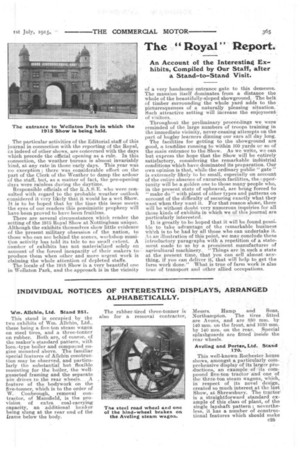
Page 12

Page 13
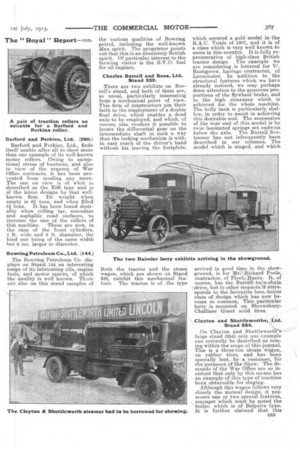
Page 14

Page 15

Page 16
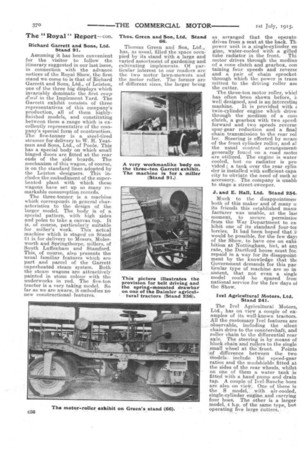
Page 17
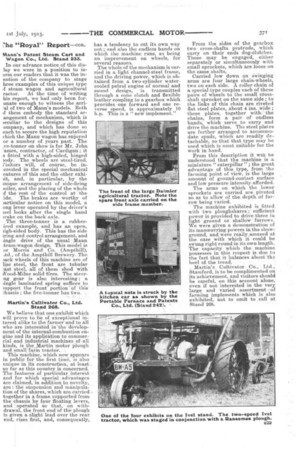
Page 18
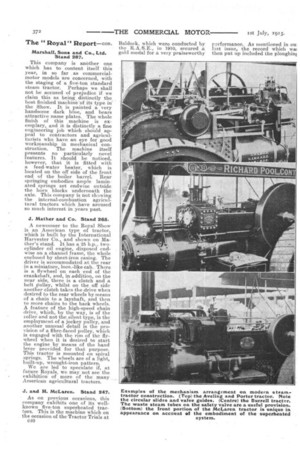
Page 19

Page 20
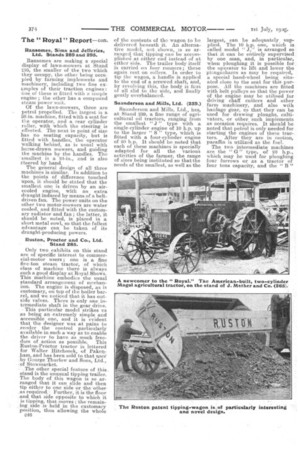
Page 21
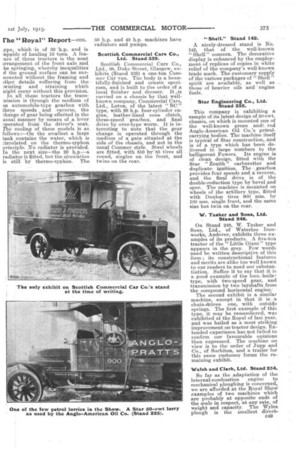
Page 22
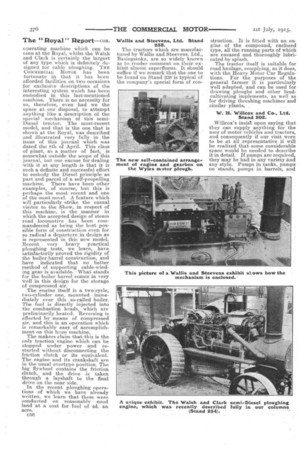
Page 23

Page 24
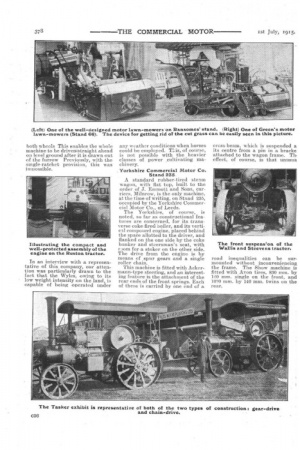
If you've noticed an error in this article please click here to report it so we can fix it.
Allchin, Ltd. Stand 251.
This stand is occupied by the two exhibits of Wm. Allchin, Ltd., these being a five-ton steam wagon on steel tires, and a three-tonner on rubber. Both are, of course, of the maker's standard pattern, with loco.-type boiler and compound engine mounted above. The familiar special features of Alichin construction may be observed, and particularly the substantial but flexible mounting for the boiler, the wellgusseted framing and the separate in drives to the rear wheels. A feature of the bodywork on the five-tonner, which is to the order of W. Coubrough, removal contractor, of Mansfield, is the provision of extra coal-carrying capacity, an additional bitnker being slung at the rear end of the frame below the body. The rubber-tired three-tonner is also for a removal contractor,
Messrs. Hamp and Sons, Northampton. The tires fitted are Avons, and are 850 mm. by 140 ram. on the front, and 1020 mm. by 140 mm. on the rear. Special splashguards are fitted inside the rear wheels.
Aveling and Porteri,Ltd. Stand This well-known Rochester house shows, amongst a particularly comprehensive display of its larger productions, an example of its compound five-ton tractor and one of the three-ton steam wagons which, in respect of its novel 'design, created so much interest at the last Show, at Shrewsbury. The tractor is a straightforward standard example of this class of plant, of the single la,y,shaft pattern; • nevertheless, it has a number of constructional features which should make a particular appeal to those who are contemplating such a purchase. We should note that the firebox is of the Belpaire pattern, and this is a construction which is distinctly advantageous in respect, of steaming capacity. The usual disposition of the mechanism is to be found on this model. The final gear is on the near side, _whilst on the off side a winding drum of relatively small diameter is mounted. The pump is on the near side of the engine frame, and its eccentric is carried on a special layshaft geared direct from Fr ant suspension on steam wagons and tractors. (Top) long, single, inverted, laminated spring and centre pivot on the latest Aveling and Porter wagon. Note the Ackermann steering and the ends of the tie rods which anchor the axle to the firebox. The front suspension of the tractor is shown in the next column. (Centre) the short, single laminated spring, with its two links, on the McLaren superheated tractor. (Bottom) the strong, well-cambered, single, laminated spring on the Burrell rubber-tired steam the crankshaft. A capacious belly tank is slung beneath the boiler.
Turning to the three-ton wagon, we find that the example shown is one for Russell's Gravesend Brewery, Ltd. It is attractively finished in brown, with the underworks painted red. The body is a lowsided hinged one, whilst a very effective canopy is provided. The general design of the machine is on the normal standard loco.-boiler
the compound engine conforming n general to modern practice.
We have already drawn attention in previous notices of this machine to the placing of the forecarriage under the front of the boiler barrel, instead of, as is more usual, under the smokebox. This gives the machine quite a distinctive appearance. and from the practical point of view it facilitates its turning by reducing the wheelbase. The axle itself, which is of generous proportions, is tied to the front of the fire
box through suitable rods and a big universal pin joint.. Another innovation in respect of steam-wagon design is the embodiment of Ackermann steering, and this particular detail in this model is a carefully-conceived one. All the components are substantial and well proportioned, and it is noteworthy that ample means of adjustment are provided on both the cross rod and the fore-and-aft rod, the latter connecting the worm and worm-wheel gear with the near-side stub-axle lever through generouslyproportioned hall joints. This particular machine is mounted on Macintosh tires.
Barford and Perkins, Ltd. (280.) Barford and Perkins, Ltd., finds itself unable after all to show more than one example of its well-known motor rollers. Owing to exceptional stress of business, and also in view of the urgency of War Office contracts, it has been prevented from sending any more. The one on view is of what is described as the E3S type and is Of the latest designs by that wellknown firm. Its weight when empty is 6,-t tons' and when filled 8i tons. It has been found desirable when rollincr, tar, macadam and a,sphaltie road surfaces, to increase the size of the rollers of thin machine. These are now, in the case of the front cylinders, 4 ft. wide and 3 ft. diameter, the hind one being of the same width but 6 ins, larger in diameter.
Bowring Petroleutn Co., Ltd. (144.) The Bowring Petroleum Co. displays on Stand 144 an interesting range of its lubricating oils, engine fuels, and motor spirits, of which the quality is well known. There are also on this stand samples of
the 'various qualities of Bowring petrol, including the well-known Mex spirit. The proprietor points out that this is an absolutely British spirit. Of particular interest to the farming visitor is the B.V.O. fuel for oil engines.
Charles Burrell and Sons, Ltd. . Stand 232.
There are two exhibits on Burrell's stand, and both of them are, as usual, particularly interesting from a mechanical point a view. This firm of constructors pin their faith to the employment of a double final drive, which enables a dead axle to be employed, and which, of course, also renders it possible to locate the differential gear on the intermediate shaft in such a way that the locking mechanism is within easy reach of the driver's band without his leaving the footplate.
Both the tractor and the steam wagon, which ore shown on Stand 232, exhibit this mechanical feature. The tractor is of the type
which secured a gold medal in the R.A.C. Trials of 1907, and it is of a class which is very well known to users in this country. It is fully representative of high-class British tractor design. The example we are considering is lettered for W. Rushgrove, haulage contractor, of Leominster. In addition to the structural features which we have already noticed, we may perhaps draw attention to the generous proportions of the flywheel brake, and to the high clearance which is achieved for the whole machine. The belly tank is particularly shallow, in order to assist in achieving this desirable end. The suspension of the rear end of this model is by twin laminated springs set endwise below the axle. The Burrell 'fivetonner has not infrequently been describedin our columns. The model which is staged, and which
arrived in good time in the showground, is for Mr.k'llichard Poole, contractor, of Fleet'Olants. It, of course, has the Burrell twin-chain drive, but in other respects it corresponds to the favourite loco.-boiler class of design which has now become so common, This particular lorry is mounted on ShrewsburyChalliner Giant solid tires.
Clayton and Shuttleworths, Ltd.
• Stand 284.
On Clayton and Shuttleworth's large stand (284) only one example can correctly be described as coming within the scope of this journal. This is a three-ton steam wagon, on rubber tires, and has been specially lent, by a customer, for the purposes of the Show. The demands of the War Office are so in-. sistent that only by this means has an example of this type of machine been obtainable for staging.
Although this wagon follows very closely the normal design, it possesses bne or two special features, amongst which must be noted the boiler, which is of Belpaire type. It is further claimed that this
machine is rather stronger in regard to its axle construction than others of similar design, and a special point has been made of accessilaility. it had been arranged to show on this stand one of the company's standard tractors, but here again Government demands had to be given first consideration,. and this further interesting exhibit was not available.
Daimler Co., Ltd. Stand 256.
The Daimler CO., Ltd., on Stand No. 236, shows various examples of interest to commercial-motor users.
Two of the large and heavy-oil tractors are on view, as well as a couple of standard types of internal-combustion-engine motor lorries. Perhaps the most interesting exhibit from an R.A.S.E. point of view will be the large 105 h.p. oil tractor. This machine is fitted -with a sixcylinder engine, both bore and stroke being 150 mm. by 150 mm.
The tractor itself has a very imposing appearance ; it weighs, when ready for the road, not less than 12 tons, and is capable of hauling 32 tons, In .external appearance it is distinctive, and the mechanism is compactly stowed. The engine is situated amidships and can be started from either side by means of starting handles, which are in duplicate. That part of the machine which corresponds to the smoke-box on a steamer contains the radiator, and a draught of; cooling air is induced through this by taking the exhaust from the engine through a chimney above. The drive from the engine is through a cone clutch, two-speedand-reverse gearbox, then to a large worm and wheel, and thence the final reduction is. by, means of large spur gears. On the ,off-side rear wheel a winding drum is situated; this can be readily thrown in and out of gear with the road wheels. We noticed that a spare front axle is slung on the near side of the frame and on inquiry discovered that this is specially arranged to take wheels suitable for rtinning on ordinary railway ;metals: . Provision is made also for replacing the ordinary rear road wheels by others for a sinairar 'purpose. The tractor is provided with a differential locking gear 'Which can be operated from the driver's seat.
The other exhibit of the same nature is a 40 h.p. fonrcylinder machine. It is constructed on the same lines as the larger one just described, and is sold as a 16-ton tractor. The former machine is found particularly useful imI agricultural districts in the undeveloped areas of North and Smith America, The latter one is admirably adapted for general farm purposes such as ob
tain in this country. :
Two petrol lorries are staged in addition to the tractor exhibits. These are of the maker's well-known two and three-ton standard pattern, as being built for the War Office ; they are painted military grey.
Fastnut Ltd. Stand 295.
Stand 203 includes the usual varied assortment _ of locking washers which are amongst the specialities of Fastnut Ltd. In addition, one may also examine the ingenious self-adjusting automatic spanners and wrenches, for which this company is by now almost as well known as for the locking device. There also one may inspect the Fast-Grippatent file handle. Fodens, Ltd. Stand 246.
The proverb " Better late than ever" seems to be particularly apreciated by exhibitors at the l,oyal Show, on the present occaion, perhaps, more than on preions ones. There is no doubt that -inch of this tardiness is due, this ear, to the difficulty of finding the ime necessary for preparing and Lelivering Show material, owing to he pressure of -work for war parioses.
Undoubtedly Fodens, Ltd., of iandbach, can claim to have sufered on this account ; indeed it was question, at one time. as to vhether any of these well-famed vagons were going to be available or the purpose. However, we were ust making up our minds to the nevitable, and preparing to record 'nothing doing, ' when one of the rtandard five-ton steel-tired maAlines put in an appearance. This las been built to the order of a ganchester carrier, and presents ill the usual features of this Wellmown and original design, which
ncludes a loco.-type -boiler, overlead, compound engine„ using steam at 230 lb'. Pressare,-drive spur gear and -long chaln -to diferential gear on the rear axle.
William Foster and Co, Ltd. Stand 283.
It will be a matter of regret to iany of our readers who will ,visit tie Royal Show,to find that Wit. A. Foster and Co., Ltd., the wellknown engineering concern of Lincolnt. has, for the first time for some years, been unable, through stress of Government and other work, to furnish an example of its interesting steam tractor for inclusion on this stand.
John Fowler and Co. (Leeds), Ltd. Stand 171.
We here find this company's latest example of the self-contained two-share motor plough, which it Manufactures under the Wyles patents. This maker has retained the general arrangement of the components forming this interesting little implement, but in this example the single-cylinder engine is placed under a neatly-finished bonnet, and behind a radiator of regular commercial-vehicle design, viz., one in which the use of vertical tubes and of cast headers is embodied. The cooling of the engine is by thermo-syphon by means of amply-proportioned inlet and outlet water pipes. The drive from this engine is taken lengthwise of the frame through a cone clutch and disc coupling to the main worm,reduction. Thence, through the crossshafts, it drives independently, through spur-gear reduction, 'the main road wheels. Each of these latter is mounted independently and radially from the pinion housing. Vertical screw adjustment is provided for each, which enables the wheels to be independently set vertically. The wheels themselves are of the steel-disc type, and provision is made for the attachment of spuds if necessary. The arrangement for the clutching or declutching of each wheel separately consists of control carried near the driver's position to the rear of the machine. There is also, similarly accessible, a substantial lever which operates the lifting gear of the plough frame. The Fowler example of this construction now provides a tail roller, which is adjustable vertically, and this facilitates the carrying of a seat for the operator ; it is interconnected in such a, way as to provide for raising of the shares at the headlands. The lateral flexibility, to provide for steerage, is on the principle which has hitherto been embodied, and consists of a special form of roller mounting on a radial track. Richard Garrett and Sons, Ltd. Stand 91.
Assuming it has been convenient for the visitor to follow the itinerary suggested in our last issue, in connection with the advance notices of the Royal Show, the first stand we come to is that of Richard Garrett and Sons, Ltd., of Leiston, one of the three big displays which invariably dominate the first coup d'ail in the Implement Yard. The Garrett exhibit consists of three representatives of this company's production, all of them highlyfinished models, and constituting between them a range which is excellently representative of the company's special form of construction. The five-tonner is a steel-tired steamer for delivery to W. H. Yeatman and Sons, Ltd., of Poole. This has a special body on which small hinged doors are fitted at the rear ends of the side boards. The mechanism of this wagon, of course, is on the standard lines adopted by the Leiston designers. This includes the embodiment of the superheated plant with which these wagons have set up so many remarkable consumption records.
The three-tonner is a machine which corresponds in general characteristics to the design of the larger model. The body is of a special pattern, with high sides and poles to take a canvas top. It is, of course, particularly suitable for miller's work. This actual machine which is staged on Stand el is for delivery to Messrs. Molesworth and Springthorpe, millers, of South Luffenham and Stamford. This, of course, also presents the usual familiar features which are part and parcel of the Garrett superheated steam system. Both the steam wagons are attractively painted in stone colour with the underworks in red. The five-ton tractor is a very taking model. So far as we are aware, it embodies no new constructional features.
Thos. Green and Son, Ltd. Stand 66.
Thomas Green and Son, Ltd., has, as usual, filled the space occupied by its stand with a large and varied assortment of gardening and cultivating implements. Of particular interest to our readers are the two motor lawn-mowers and the motor roller. The former are of different sizes, the larger being
so arranged that the operato: drivesfrom .a seat at the back. Th. power unit is a single-cylinder en gine, water-cooled with a gilled tube radiator in the front. • Thi motor drives through the mediun of a cone clutch and gearbox, Con taming four speeds and reverse and a pair of chain sprocket. through which the power is trans milted to the driving roller an the cutter.
The three-ton motor roller, whicl has often been shown before, i: well designed, and is an interestin$ machine. It is provided with 1 twin-cylinder engine which drive: through the medium of a coin clutch, a gearbox with two speed: forward and two speeds reverse spur-gear reduction and a final chain transmission to the rear rdl ler. Steering is effected by mean: of the front cylinder roller, and al the usual control arrangeinent generally found on a road motoi are utilized. The engine is water cooled, but no radiator is pro vided ; a tank over the rear cylin. der is installed with sufficient eapa city to obviate the need of such ar accessory. The company is unabh to stage a street-sweeper.
J. and E. Hall, Ltd. Stand 234.
Much to the disappointmerr both of this maker and of many o. its friends this established mann. facturer was unable, at the last moment, to secure permissioz from the War Department' to ex. hibit one of its standard four-tor lorries. It had been hoped that it would be possible, for the few day of the Show, to have one on exhi. bition. at Nottingham, but, at an rate, the Dartford house must .fee. repaid in a way for its disappoint. ment by the knowledge that Government demands for this par. ticular type of machine are so insistent, that not even a singl€ model could be spared Iroir national service for the few days oi the Show.
Ivel Agricultural Motors, Ltd. Stand 241.
The Ivel Agricultural Motors, Ltd., has on view a, couple of examples of its well-known tractors. All the customary Ivel features are observable, including the silent chain drive to the countershaft, and roller chain to the differential rear axle. The steering is by means of block chain and rollers to the single small wheel at the *out. Points of difference between the two models include the speed-gear ratios and the mudshields fitted at the sides of the rear wheels, whilst on one of them a water tank is fitted with a hand pump and drain tap. A couple of Ivel-Bauche hoes are also on vier. One of these is the S model,. with air-cooled, single-cylinder engine and carrying four hoes. The other is a larger model, 4 h.p. of the same type, brut operating five large cutters.. Kann's Patent Steam Cart and Wagon Co., Ltd. Stand 235.
In our advance notice of this dislay we were in a position to inorm our readers that it was the inention of the company to stage hree examples of this unique type .f steam wagon and agricultural ractor. At the time of writing his report, we had only been forunate enough to witness the arri.al of two of Mann's models. Both
■ 1 them embody the standard arangement of mechanism, which is )eculiar to the designs of this ompany, and which has done so nuch to secure the high reputation vhieh the Mann wagon has enjoyed or a number of years past. The se-tanner on show is for Mr. John ames, contractor, of Cardigan ; it s fitted with a high-sided, hinged )ody. The wheels are steel-tired. Tisitors will, of course, be incrested in the special mechanical eatures of this and the other exhidt, and, in particular, by the inique arrangement of side-firing miler, and the placing of the whole If the rest of the control at the ide. The brakes are worthy of )articular notice on this model, a ong lever operated by the driver's led looks after the single band wake on the back axle.
The three-tonner is a rubberired example', and has an open, ugh-sided body. This has the side tring and control arrangement, and ,ingle drive of the usual Mann team-wagon design. This model is or Morris and Co. (Ampthill), Ad., of the Ampthill Brewery. The )ack wheels of this machine are of lire steel, the front are tubular mst steel, all of them shod with Atom-I-Milne solid tires. The steerng gear is also interesting ; angle laminated spring suffices to cupport the frontportion of this ihassis ; the five-tanner has two.
Martin's Cultivator Co., Ltd. Stand 268.
We believe that one ,exhibit which will prove to be of exceptional interest alike to the farmer and to all who are interested in' the slevelbpment of the internal-combustion engine and its application to commercial and industrial Machines of Call kinds, is.the ,Martin motor plough and small faith. tractor.
This machine, which now appears in public for' the first time, is also unique in its construction, at least so far as this country is concerned. The features of particular interest and for which special advantages are claimed, in addition to novelty, are : the suspension and manipulation of the shares,. which are.carried together in a frame supported from the chassis by four floating levers, and operated Po that, on withdrawal, the front end ofthe plough is given a slight lead over the rear end, rises first, and, consequently, has a tendency to cut its own way out ; and also the endless bands on Which the machine runs, as being an improvement on wheels, for several reasons.
The whole of the mechanism is carried in a light channel-steel frame, and the driving power, which is obtained from a two-cylinder watercooled petrol engine of normal and sound design, is transmitted through a cone clutch and flexible leather coupling to a gearbox which provides one forward and one reverse speed, is approximately 10 h.p. This is a "new implement." From the sides of the gearbox two cross-shafts protrude, which carry on their ends dog-clutches. These may be engaged, either separately or simultaneously with small sprockets, which are loose on the same shafts.
Carried low -down On swinging arms are four large chain-wheels, two on each side. A roller chain of a special type couples each of these pairs of wheels to the small cross shaft sprocket on the same side ; to the links of this chain are riveted flat steel plates, about 4 ins. wide ; these plates, together with, the chains, form a pair of endless bands, which serve to carry and drive the machine. The steel plates are further arranged to accommodate spuds, which are readily detachable, so that that type may be used which is most suitable for the work in hand.
From this description it will be understood that the machine is a miniature " caterpillar " ; the great advantage of this type, from the farming point of view, is the large amount of ground-contact surface and low pressure intensity afforded.
The arms on which the lower sprockets are carried are pivoted so as to allow of the depth of furrow being varied.
The machine exhibited is fitted with two ploughshares ; sufficient power is provided to drive three in light ground or 'shallowfurrows. We were given a demonstration or its manceuvring powers in he show ground, and'ivere re-aily.ama.zed at the ease with which it •could be swung right round in its own length. The capacity which the machine possesses in this respect is due to the fact that it balances about tha
heel of. the tread. .
Martin's Cultivator CO., Ltd., Stamford, is to be complimented on its achievement, and visitors should. be careful, on this account alone, even if not interested in the very large and varied assortment ... of farming implements which is also exhibited, net to omit to call at Stand 268.
Marshall, Sons and Co„ Ltd. Stand 287.
This company is another one which has to content itself this year, in so far as commercialmotor models are concerned, with the staging of a five-ton standard steam tractor. Perhaps we shall not be accused of prejudice if we claim this as being, distinctly the best finished machine "of its type in' the Show. It is painted a very handsome dark blue, and bears attractive name plates. The whole finish of this machine is exemplary, and it is distinctly a fine engineering job which should appeal to contractors and agriculturists who have an eye for good workmanship in mechanical construction. The machine itself presents no particularly novel features. It should be noticed, however, that it is fitted with a feed-water heater, which is located on the off side of the front end of the boiler barrel. Rear springing embodies ample laminated springs set endwise outside the horn blocks underneath the axle. This company is not showing the internal-combustion agricultural tractors which have aroused so much interest in years past.
J. Mather and Co. Stand 265.
A newcomer to the Royal Show is an American type of tractor, which is built by the International Harvester Co., and shown on Mather's stand. It has a25 h.p., twocylinder oil engine, disposed endwise on a channel frame, the whole enclosed by sheet-iron casing. The driver is accommodated at the rear in a miniature, loco.-like cab. There is a flywheel on each end of the crankshaft, and, in addition, on the near side, there is a clutch and a belt pulley, whilst on the off side another clutch takes the drive when desired to the rear wheels by means of a chain to a layshaft, and then to more chains to the back wheels. A feature of the high-speed chain drive, which, by the way, is of the loner and not the silent type, is the employment of a jockey pulley, and another unusual detail is the provision of a fibre-faced pulley, which is engaged with the rim of the flywheel when it is desired to start the engine by means of the hand lever provided for that purpose. This tractor is mounted on spiral springs. The wheels are of a light, built-up, wrought-iron pattern.
We are led to speculate if, at future Royals, we may not see the exhibition of more of the many American agricultural tractors.
J. and H. McLaren. Stand 247.
As on previous occasions, this company exhibits one of its wellknown five-ton superheated tractors. This is the machine which on the occasion of the Tractor Trials at c40 Balclock, which were conducted by p:3rformance.. As mentioned in on: the in 1910, secured a hst issue, the record which wat gold medal for a very praiseworthy then put up included the ploughinE The "Royal" Report--con. tion of 273 lb. of coal, or less than 55 lb per acre, a very creditable of five acres of land at the rate of performance indeed, and one which one acre per hour, with a consumpis a distinct feather in the cap of
those manufacturers who have pinned their faith to superheating for this class of plant. The machine as a wbnie corresponds to the standard tractor design, but its front portion is unique in appearance on account of the inclusion of the feed. water fitments, and the accessories which are necessitated by the provision for superheating.
Merryweather and Sons, Ltd. Stand 527.
In addition to the usual hand pumps, allerryweather's, on Stand 327, have on view a standard 250gallon motor pump. ThiS is not an exhibit in the ordinary sense of the word, as it is kept in readiness at any time, in case of a fire at any of the stands. It is fitted with a 20 h.p. engine, and a standard Hatfield pump of the above-Mentioned capacity.
The North British Rubber Co„ Ltd. Stand 72.
The North British Rubber Co., exhibits on Stand 72 a varied :assortment of commercial-vehicle solid tires, both large and small. Samples may also be seen of the company's belting, bah indiarubber and Balata, suction-delivery hose, valves and washers, indiarubber matting and all kinds of vulcanite goods.
The Portable Furnace and Patents Co., Ltd. Stand 242.
This company has on . view a Church Army kitchen car on -a Willys-Overland one-ton chassis. The body, which is by the wellknown firm of Brown, Hughes and Strachan, is fitted up-with the -usual kettles, steam heaters, racks for utensils, and so on. The particular and special feature of this one is that the heating is by oil, which is a patented arrangement by the above maker. An unexpected feature of the bodywork is the roominess of -it, notwithstanding the very full internal equipment that is carried. We understand that immediately the Show is over this machine will be taken over to France.
Price's Co., Ltd. Stand 255.
Price's are entitled to-a stand in the " Implements in Motihn" section on account of their powerdriven friction-testing. device. As a matter of fact, the commodities . in which this . company specializes are to be found on most of the stands in this section of the Show, so that No. 255 generally serves as a place where one May • hear all the latest -news in the, lubrication world. The needs oftractor and wagon drivers and makers are particularly cared for. • It is in
• tere.sting to recall that the organizers of our Campaign Comforts Fund have been enabled to make very considerable purchases from this old-established concern. Ransomes, Sims and Jefferies, Ltd. Stands 289 and 295.
Ransomes are making a special display of lawn-mowers at Stand is•95, the smaller of the two which they occupy, the other being occupied by farming implements and ilachinery, including two fine examples of their traction engines : One of these is fitted with a simple engine ; the other has a compound steam power unit.
Of the lawn-mowers, three are petrol propelled. The largest is a 36-in, machine, fitted with a seat for the operator, and a rear cylinder roller, with which the steering is effected. The next in point of size has no seating capacity, but is fitted with handles, the operator walking behind, as is usual with horse-drawn mowers, and guiding the machine by the handles. The smallest is a 24-in., and is also steered by hand.
The general design of all three machines is similar. In addition to the points of difference touched upon, it should be stated that the smallest one is driven by an airco cad engine, with an extra draught induced by means of a beltdriven fan. The power units on the other two motor-mowers are water cooled, and fitted with the customary radiator and fan ; the latter, it should be noted, is placed in a, short metal cowl, so that the fullest advantage can be taken of its draught-producing powers.
Ruston, Proctor and Cob, Ltd.
• Stand 285.
Only two exhibits on this stand are of specific interest to commercial-motor users ; one is a fine five-ton steam tractor, of which class of machine there is always such a good display at Royal Shows. This machine embodies the usual standard arrangement of mechanism. The engine is disposed, as is customary, on too of the boiler barrel, and we noticed that it has outside valves. There is only one intermediate shaft in the gear drive. This particular model strikes us as being an • extremely simple and accessible one, and it is evident that the designer was at pains to render the control particularly available in such a way as to enable the driver to have as much freedom of action as possible. This Ruston-Proctor tractor is lettered for Walter Hitchcock, of Pakertham, and has been sold to that itsei by George Thurlow and Sons, Ltd., -of Stowmarket.
. The other special feature of this stand is the unusual tipping trailer. The body of this wagon is so arranged that it can slide and then tip either to one side or the .other . as required: Further, it is the floor . and that side opposite to which it is tipping, that .moves ; the-remain. ing. side is-held in the customary position, thus allowing the whole 046 of the contents of the wagon to be delivered beneath it. An alternative model, not shown, :s so arranged. that tipping can be accomplisheu at either end instead of at either side. The trailer body itself is carried on four runners ; these again rest on rollers. In order . to tip the wagon, a handle is applied to the end of a screwed shaft, and, by revolving this, the body is first of all slid to the side, and finally gently overbalanced.
Saunderson and Mills, Ltd. (239.) Saunderson and Mills, Ltd., has, at Stand 239, a fine range of agricultural oil tractors, ranging from the smallest " J " type with a single-cylinder engine of 10 h.p. up to the larger " S " type, which is fitted with a four-cylinder engine of '50 h.p. It should be noted that each of these machines is specially adapted for all the various activities of the farmer, the range of sizes being instituted Bo that the needs of the smallest, as well as the largest, can be adequately. supplied. The JO h.p. one, which is called model "J,' is arranged so that it can be entirely supervised by one man, and, in particular, when ploughing it is possible for the operator to lift and lower the plougnshares as may be required, a special hand-wheel being, situated close to the seat for this purpose. All the machines are fitted with belt pulleys so that the power of the engine may be utilised for driving chaff cutters and other farm machinery, and also with haulage gear, so that they can be used for drawing ploughs, cultivators, •er other such implements as occasion requires. It should be noted that petrol is only needed for starting the engines of these tractors. After they are in motion, paraffin is utilized as the fuel.
The two intermediate machines are the " G " type, of 20 h.p., which may be used for ploughing four furrows or as a tractor of four tons capacity, and the " B " ype, which is of 30 h.p. and is :apable of hauling 10 tons. A f eatire of these tractors is the neat irrangement of the front axle and he springing, whereby inequalities if the ground surface can be susnounted without the framing and itlaer details suffering from the ;wisting • and straining -which night occur without this provision.
thee tractors the transmission is through the medium of tu automobile-type gearbox with three speeds and -reverse, the i
2hange of gear being effeeted n the usual manner by means of a lever Dperated froth the driver's seat. me cooling of these models is as. follows :—On the smallest a large tank contains the water, which is 2irculated on the thermo-syphon principle. No radiator is provided. En the next size—the 20 h.p.—a radiator is fitted, but the circulation is still by thermo-syphon. The
30 h.p. and 40 h.p. machines have radiators and pumps.
Scottish Commercial Cars Co., Ltd. Stand 559.
Scottish Commercial Cars Co., Ltd., 98, Duke Street, Glasgow. exhibits (Stand 339) a one-ton Cornsuer Car van. The body is a beautifully-finished and ornate specimen, and is built to the order of a local finisher and dresser. It ,is carried on a chassis by that wellknown company, Commercial Cars, Ltd., Luton, of the latest " BC " type, with 20 h.p. four-cylinder engine, leather-lined cone clutch, three-speed gearbox, and final drive by over-type worm. It is interesting to note that the gear change is operated through the medium of a gate situated at the side of the chassis, and not in the usual Commer style. Steel wheels are fitted, with 850 by '85 tires all round, singles on the front, and twins on the rear.
"Shell." Stand 142.
A nicely-dressed stand is No. 142, that of the well-known "Shell" concern. The decorative display is enhanced by the employment of replicas of copies in white relief of the company's well-known trade mark. The customary supply of the various packages of " Shell " spirit are available, as well as those of heavier oils and engine Star Engineering Co„ Ltd. Stand 225.
This company is exhibiting a sample of its latest design of 50-cwt. chassis, on which is mounted one of the well-known green andf, red Anglo-American Oil Co.'s petrolcarrying bodies. The machine itself is typical of Star construction, and is of a type which has been delivered in large numbers to the belligerent Powers. Its engine is of clean design, fitted with the Star " Zenith ' carburetter and duplicateignition. The gearbox provides four speeds and a reverse, and the final drive is of the double-reduction type by bevel and spur. The machine is mounted on wheels of the artillery type, fitted with Dunlop tires 900 mm. by 100 mm. single front, and the same size but twin on the rear.
W. Tasker and Sons, Ltd. Stand 248.
On Stand 248, W. Tasker and Sons, Ltd., of Waterloo Ironworks, Andover, exhibits three examples of its products. A five-ton tractor of the "Little Giant" type appears in the grey. Few words need be written descriptive of this item ; its constructional features and merits are alike too well known to our readers to need our substantiation. Suffice it to say that it is a good example of the loco.-boiles type, with two-speed gear, and transmission by two layshafts from the compound horizontal engine: The second exhibit is a ,similar machine, except in that it is a chain-driven one, with outside springs. The first example of this type, it may be remembered, was exhibited at the Royal of last year, and was hailed as a most striking improvement on tractor design. Extended experience has not failed to confirm our favourable opinions then expressed. The machine on view is to the order of Jupp and Co., of Surbiton, and a trailer for this •same customer forms the remaining exhibit.
Walsh and Clark, Ltd. Stand 254.
So far as the adaptation of the internal-combustion engine to mechanical ploughing is concerned, we are afforded at the Royal Show examples of two machines which are probably at opposite ends of the scale in respect, at any rate, of weight and capacity. The Wyles plough is the smallest direct
operating machine which can be seen at the Royal, whilst the Walsh and Clark is certainly the largest of any type which is definitely designed for cable ploughing. THE COMMERCIAL MOTOR has been fortunate in that it has been afforded facilities on two occasions for exclusive descriptions of the interesting system wnich has been embodied in this last-mentioned machine. There is no necessity for us, therefore, even had we the space at our disposal, to attempt anything like a description of the special mechanism of this semiDiesel tractor. The most-recent model, and that is the one that is shown at the Royal, was described and illustrated very fully in the issue of this journal which was dated the 8th of April. This class of plant, as a matter of fact, is Somewhat outside the scope of this journal, but our excuse for dealing with it at any length is that it is such a definite and successful effort to embody the Diesel principle as part and parcel of a self-propelling machine. There have been other examples, of course, but this is perhaps the most recent and one of the most novel. A feature which will particularly strike the casual visitor to the Show, in respect of this machine, is the manner in which the accepted design of steam road locomotive has been commandeered as being the best possible form of construction even for so radical a departure in design as i
is represented n this new model. Recent very heavy practical ploughing tests, we learn, have satisfactorily proved the riFidity of the boiler-barrel construction, and have indicated that no better method of supporting cable-winding.gear is available. What stands for the boiler barrel comes in very well in this design for the storage of compressed air.
. The engine itself is a two:cycle, two-cylinder one, mounted • immediately over this so-called boiler. The fuel is directly injected into the combustion heads, which are preliminarily heated: Reversing is effected by means of compressed air, and this is an operation which is remarkably easy of accomplishment on this huge machine.
The makers claim that this is the only traction engine which can be stopped under power and restartc,d without disconnecting the friction clutch or its equivalent. The engine and its crankshaft are in the usual overtype position. The big flywheel contains the friction clutch, and the • drive is taken through a layshaft to the final drive on the near side.
In the recent ploughing operations of which we have already written, we learn that these were conducted on reasonably good land at a cost for fuel of 4d, an acre. Wallis and Steevens, Ltd. Stand 258.
The tractors which are manufactured by Wallis and Steevens, Ltd., Basingstoke, are so widely known as to render comment on their exhibit almcist superfluous. It should suffice if we remark that the one to be found on Stand 238.is typical of the company's special form of con struction. It is fitted with an engine of the compound, enclosed type, all the running parts of which are .encased and thoroughly lubricated by splash.
The tractor itself is suitable for road haulage, complying, as it does, with the Heavy Motor Car Rogulations. For the purposes of the general farmer it is particularly well adapted, and can be used for drawing ploughs and other land. cultivating implements, as well as for driving threshing machines and similar plants, W. H. 'Willcox and Co., Ltd. Stand 202.
Wilcox's insisl upon saying that they can supply anything for the user of motor vehicles and tractors, and consequently if our visit were to be at all representative if will be realized that some considerable space would he needed to describe it in detail. If pumps are required, they may be had in any variety and any style. Pumps in tanks, pumps on stands, pumps in barrels, and
jumps mounted in every conceivdile manner, and of many different Tpes. Samples of the company's lubri:ating oils are available, as well as A beltings, packing and joints. kitogether the company shows a ;horoughly representative and com?rehensive range of purchases vliich should meet the needs of igriculturists and all other visitors ;o the Show. Any time spent in in examination of the wide range A exhibits on this stand will well repay any interested visitor. A very effective "display of special brass fittings, stop cocks, unions, etc., spanners, pipe wrenches, oilcans, of all kinds, is the subject of our illustration. The one depicted is typical of some half-dozen, each of which illustrates some special branch of this company's activities.
Wyles Motor Ploughs, Ltd. Stand 250.
This journal has always evinced 2onsiderable interest in that little agricultural model, the WyIes motor plough, and has followed with very considerable,keenness its development from the earliest days, when Mr. Albert Wyles was experimenting with his first small machine.
There are several examples on Stand 250, and they all embody considerable improvements since we last saw this plough at the Shrewsbury Royal Show. Perhaps the most noticeable feature in respect of constructional alteration is the new method of building the engine and gearbox together, and making them self-supporting. One of our illustrations shows the whole of the casing for the engine gear removed, and this reveals the chain drive for the magneto and the method adopted for the operation of the valve-lifting mechanism. Both the valves are below the cylinder head, and are on one side of the engine. The motor is now of 11 h.p. capacity, and this should provide an ample margin of power for a twoshare machine. Considerable modifications have been embodied in respect of the actual gear drive, and there are now, in fact, four 'shafts, including the crankshaft. The independent dog-clutches, with which either of the two driving wheels is made effective at will, are carried on the final shafts, and are part and parcel of the final-pinion construction. This new grouping . of the gears has enabled the constructors to adopt an external-gear drive to the wheels in plac.e of the more cumbrous internal one which was originally fitted. As the direct result of this improvements it has been possible to embody very effective casings for the last drives. The whole of the working mechanism of the Wyles plough now runs in oiltight casings. To anyone who has not followed the evolution of the design, partial laxly in respect of that part of it which is concerned with the raising and lowering of the plough frame, and of the driving wheels, the method finally standardized, spite of its real simplicity, is likely to appear somewhat complicated, unless adequately explained It has to be remembered that the toad wheels are pivoted radially around the centres of the final pinions. The radius frames which effect this can be raised or lowered in order to secure relative changes in height of one or both of the road wheels. By a clever arrangement of &Ole ratchets, the actual tendency of the final spur wheel to climb round its own pinion in the case of each final drive is turned to account in order to lower the wheels when it is !desired to raise the plough frame from the ground at 'a headland. The stop bars, which can be set by hand to any position, merely limit the height to which the wheels May travel, or rather, putting it in another way, they limit the depth to which the main frame of the machine May sink. They are, therefore, used for direct adjustment for the depth of ploughing.
In the last design which we inspected, the double ratchet gear to which we have drawn attention was only -applied to one of the driving wheels It is now being fittod 10 both wheols This enables the whole machine to be driveivstraight ahead on level ground after it is drawn out of the furrow Previously, with the single-ratchet provision, this was impossible.
In an interview with a representative of this company, our attention was particularly drawn to the fact that the Wyles, owing to its low weight intensity on the land, is capable of being operated under
any i.veatlx.r conditions when horses could be employed. TLis, of course, is not possible with theheavier classes of power .cultivating machinery.
Yorkshire Commercial Motor Co. Stand 235 A standard rubber-tired steam wagon, with flat top, built to the order of J. Emmott and Sons, car riers, Milnrow, is the only machine, at the time of writing, on Stand 235, occupied by the Yorkshire Commercial Motor Co., of Leeds.
The Yorkshire, of course, is noted, so far as constructional features are concerned, for its transverse coke-fired boiler, and its vertical compound engine, placed behind the space allotted to the driver, and flanked on the one side by the coke bunker and steersman's seat, with room for .a stoker on the other side. The drive from the engine is by means of spur gears and a single roller chain.
This machine is fitted with Acker mann-type steering, and an interesting feature is the attachment of the rear ends of the front springs. Each of these is carried by one end of a cross beam, which is suspended a its centre from a pin in a bracke attached to the wagon frame. ThJ effect, of course, is that unusua
road inequalities can be surmounted without inconveniencing the frame. The Show machine is fitted with Avon tires, 830 mm. by 140 mm. single on the front, and ton mm. by 140 mm. twins on the rear.


































